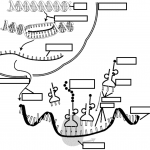TBT: Cell Museum Project
Editor’s Note: This post originally appeared in December 2015 as part of the “In My Classroom” series. The author, Andrew Taylor, is an incredible Biology teacher currently at Olathe Northwest HS. This TBT selection was motivated by a recent Tweet/Periscope storm from Jessica Popescu (mentioned in this post) regarding #CellMuseum2016. Take it away, Andrew!
Students in my classroom recently completed a project based learning unit centered around the driving question ‘How can we, as museum exhibit designers, build a museum exhibit about a somatic cell type that will engage younger audiences?’ The question came about as a collaboration between myself, Jessica Popescu, who teaches one door down from me, and the staff at the Columbus Museum in Georgia, most specifically Rebecca Bush, the curator of history. The project consisted of students working in teams of three to four. The teams first divided themselves up into specific roles and selected a somatic cell type to research and display. The potential roles each had real-world parallels in the museum industry. Role options consisted of a marketing director, a manipulative designer, an application letter writer, and a presentation specialist. The Columbus Museum emphasized how these roles relate to their real world job responsibilities in a video displayed to the students early in the project. The video also included several example exhibits within the museum and information as to what type of items the staff looks for in a museum exhibit.
The reason we decided to have students design their exhibits around a specific cell type, as opposed to just ‘animal’ or ‘plant’ cell was to help students understand the interactions, and the importance of those interactions, between different cells in a multi-cellular organism. Students had baseline knowledge of cell organelles, the cell membrane, and cellular transport when the project began.
The project as a whole was very successful. Students created a variety of excellent products, a few of which are pictured in this post. Additionally, students took pride in displaying their exhibits to students from a variety of different classrooms. Also present for presentations and ‘museum walks’ were teachers from throughout the school and various members of the administration. The students will also receive feedback on their final products from the staff at the Columbus Museum. One of the most significant signs of success to me was the way in which students generated questions throughout their research. A moment that sticks out to me occurred as a student attempting to do the bare minimum and simply draw a picture of a red blood cell (their cell type), asked the question, ‘Why don’t red blood cells have many organelles?’ This question led him down a path of discovery that led to another question, ‘If red blood cells don’t have a nucleus, then they probably don’t have DNA which is needed to make protein, so how in the world do they have a large supply of the protein ‘hemoglobin?’ Another example of a questioning attitude is drawn from Mrs. Popescu’s classroom. A group of students researching cone cells asked another group why they decided to color their cone cell model yellow when humans only have cone cells for red, blue, and green.
In completing the project next year, I will strive to offer students more opportunities at receiving feedback before the final displays are done. Also, while the student generated questions were awesome, my goal is to structure the project so that more students begin asking these types of thought provoking questions.
Happy holidays everyone, and now I’ll throw it back over to Brittany Roper for the first post of the new year.


 Next Post
Next Post